2023 PortSide year-end report
/Recap of PortSide’s 2023 impact on public policy, education, and historic preservation! And the year’s not over! There are December milestones and news in here!
Read MoreNYC needs more #piers4boats! PortSide’s blog covers our WaterStories programs, urban waterways issues, the BLUEspace, development plans for the NYC waterfront, our ship MARY A. WHALEN, other historic vessels, and boats and ships of all sizes.
Recap of PortSide’s 2023 impact on public policy, education, and historic preservation! And the year’s not over! There are December milestones and news in here!
Read MoreFrenchman Nicolas Anderson of Red Hook offered to cook and serve free cassoulet for volunteers which attracted a large, happy and productive crowd.
Read MoreThis year our partnership with Local 806, the bridge painters of District Council 9 (DC9) really ramped up. They are using the MARY A. WHALEN as a training site.
Read MoreGreat to see weathered teak woodwork go from grey to gold! Great to see youth learn to do it! Read how Christopher, Christie, Cesar, Devere and Jose describe their summer, in their own words.
Read MorePortSide opened the MARY A. WHALEN for Sunday of OHNY Weekend. Our ship MARY worked her magic, and so did our ship cat Chiclet who was a magnet in her own right. Our "Salty Selfies" photo station provided great souvenir moments. We believe in having fun while learning maritime history! If you missed this, come enjoy the main deck for #TankerTime!
Read MoreA water-themed history trail about and for fascinating Red Hook, Brooklyn. It will educate visitors and locals, help revitalize Red Hook and help protect this community from floods. It tells NYC's maritime story in microcosm. This year, we are launching a pilot multimedia map and creating a hard copy visitor guide and signs with QR codes around the neighborhood that alert people to the website. We will create large, outdoor, exhibit panels with this content. We are taping more oral histories to share.
PortSide offices aboard the ship MARY A. WHALEN are a buzz as we push ahead with Red Hook WaterStories. Many new consultants and interns have come aboard to help develop and catalog content. The accessibility of our new home is allowing people with valuable skills, but no prior relationship to PortSide, to literally step (or ride their bicycle like David Levine) up to the pier and get involved.
We thank Councilman Carlos Menchaca both for seeing the importance of our new home and for the $20,000 in funding that is pushing the project forward. We have applied for other funding, and have launched a campaign to raise another $20,000 by then end of June 2016.
Our Curator and Historian Peter Rothenberg has been joined by a team of consultants, advisors and interns. Some are interviewing, some research archives, some are deep in the html end of the archive. Bios of the team on the Red Hook WaterStories webpage.
We have been collecting new content and looking backward, meaning we sought technology and advice on how to get our archive coded and organized. David Levine has 25 years experience in content management at major corporations and is leading the tech end of the project, selecting the software for content management and website creation. Lots of conversations between him, Peter and new advisors Johnathan Thayer and Marilyn Oliva helped selected us Omeka as the archivist software to use. The first version of the multimedia RHWS website may be Omeka itself. Much to learn and code in all this!
Johnathan Thayer teaches archival practice and preservation at Queens College and is the Senior Archivist at Seaman’s Church Institute, founded in 1834 which has thousands of items and oral histories in its collection. Despite all that content, they have nothing about Red Hook in their files – proof that PortSide’s project has something to contribute.
Regina Carra, a graduate student at CUNY Queens College studying Library Science and History, learned about RHWS from Johnathan and was so excited by the project that she rejiggered her schedule to work with us one day a week.
We have had long meetings and brainstorming sessions around the galley table to discuss what themes, issues and peoples to include so we know to look for such content and have the archive coded in advance to be ready to receive that kind of content. “War” and “”military,” how are they the same or different? With our focus on immigrants who arrived by water or worked on the waterfront, what do we do about the “non-ethnics,” the English or WASPS? How do we deal with false history (the errors so often repeated in the era of Google)?
Do we include a layer that explains sources so people can see that many a map or engraving that has been used to show “this was Red Hook” is an illustration of a plan, an intention, and did not yet exist? That kind of discussion is so pertinent to the resiliency (flood prep) aspect to Red Hook WaterStories.
As a water-aware organization, we planned to talk about underground water issues since we started this work in 2005. After superstorm Sandy, information about the historic filling of creeks, swamp and shoreline is very timely. It's key to understand that so many historic maps of Red Hook show a street grid of intentions over “land” that remained water and swamp into the 1900s. On a lighter note, in honor of our ship cat Chiclet and her devoted followers, we decided to add cat WaterStories. History needs to be fun too!
We have a bottomless font of facts and tips about the history in advisor Norman Brouwer, a noted maritime historian and the person who built the South Street Seaport library. He also has a personal collection of thousands of maritime postcards which we hope to access for illustrations.
Julia Golia, Director of Public History at the Brooklyn Historical Society, told us about resources in their archives and was receptive to partnering as they move ahead with their waterfront museum and waterfront history website in partnership with Brooklyn Bridge Park.
Melinda Boros, an immigrant from Romania, brings us a fresh perspective in her role as consultant. Red Hook was one of the first neighborhoods she found after emigrating in 1998. It's abandonment was something she expected in Ceaucescu’s Romania not the USA, so she dove deep into historical research to come to understand it. Barbara Wye, a recent grad in Anthropology and Digital Media Design with experience in community organizing around preservation, is helping with outreach, event planning and graphic design.
Many Red Hook WaterStories involve Spanish speakers, especially since the first point of arrival for Puerto Ricans in NYC was ships docking at Red Hook piers. Intern Ivy Ann Rosado, a senior at Hunter College of Dominican heritage is helping with this research and other aspects of the project.
We are interviewing more people for more video and oral histories. Jenny Kane leads the oral history work. John Weaver handles the video camera. Our President Carolina Salguero, an award-winning photojournalist in her prior career, does some of the interviewing.
If you, or someone you know has some Red Hook WaterStories to share, get in touch! WaterStories include: all things working waterfront (shipbuilding/repair, ports/freight movement, creation of ports/changing shoreline, merchant marine/worked on boats, ferries), emigrated here by ship, worked at waterfront facilities, played/fished/relaxed on the waterfront, waterfront religious rituals, drownings, Sandy experiences, created an art work or piece of literature inspired by the Red Hook waterfront.
This project is supported in part by the New York State Council on the Arts with the support of Governor Andrew M. Cuomo and the New York State Legislature, and funding from NYC Councilman Carlos Menchaca.
2015 was a year of major milestones and growth. See, read and feel it below.
The pivot point was the exhilarating move on May 29 in the video at right.
Our new site strengthens our ability to fulfill the PortSide vision of combining the working waterfront, public access and community development.
Please donate now and support our momentum!
The public access at our new home enables us to grow our educational programs. We hopped on it right away with outreach such as our Open House for Educators Week and researching new curricula. We gained new partners in the World Monuments Fund, the Williamsburgh HS of Architecture and Design (WHSAD), and Behind the Book. We had three summer interns from WHSAD and two college interns from Spain. We created a curriculum for simple machines aboard the MARY A. WHALEN and taught Hurricane Sandy & resiliency to elementary school kids. For adult job training, we furthered our relationship with the painters' union District Council 9.
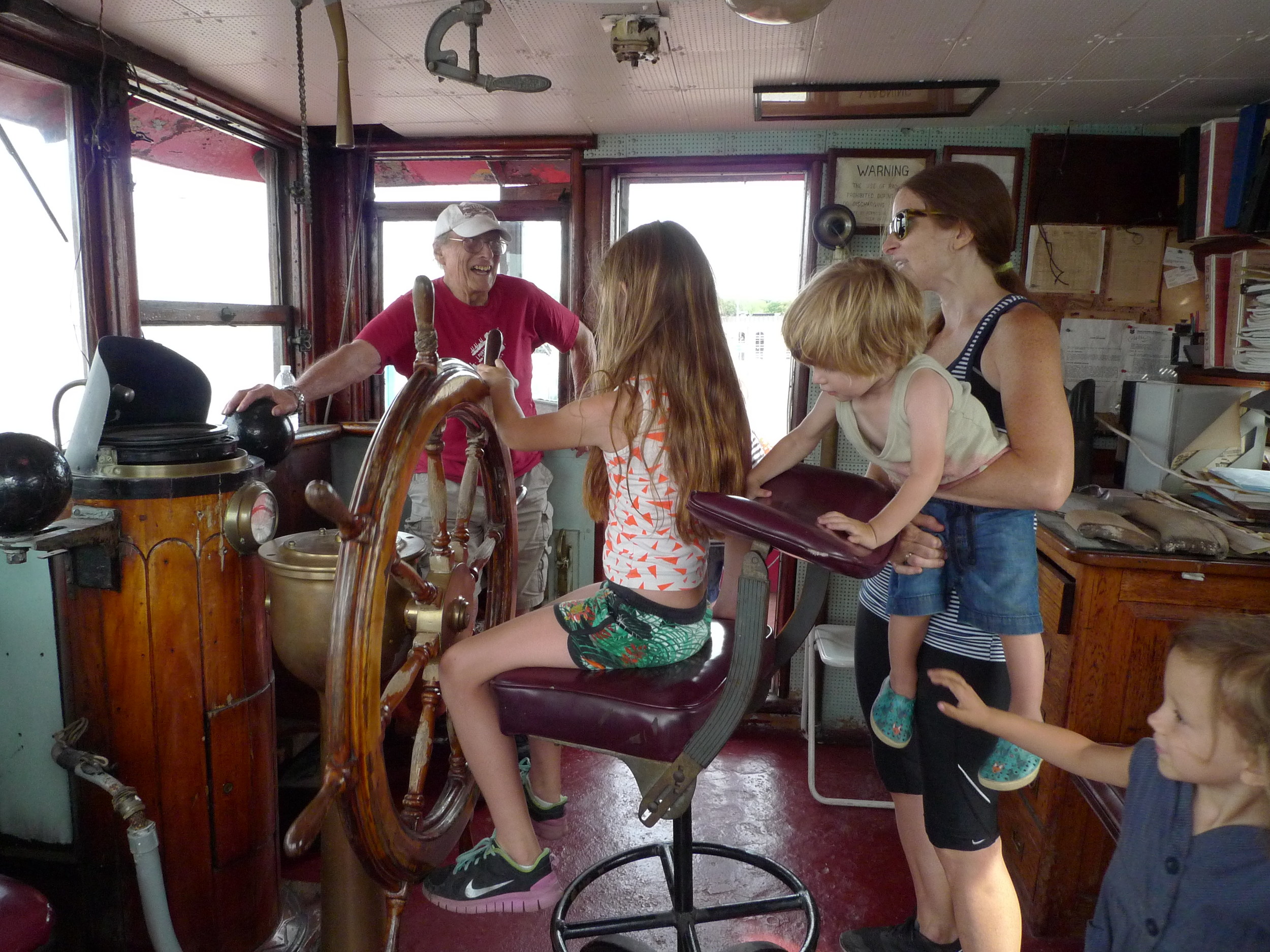
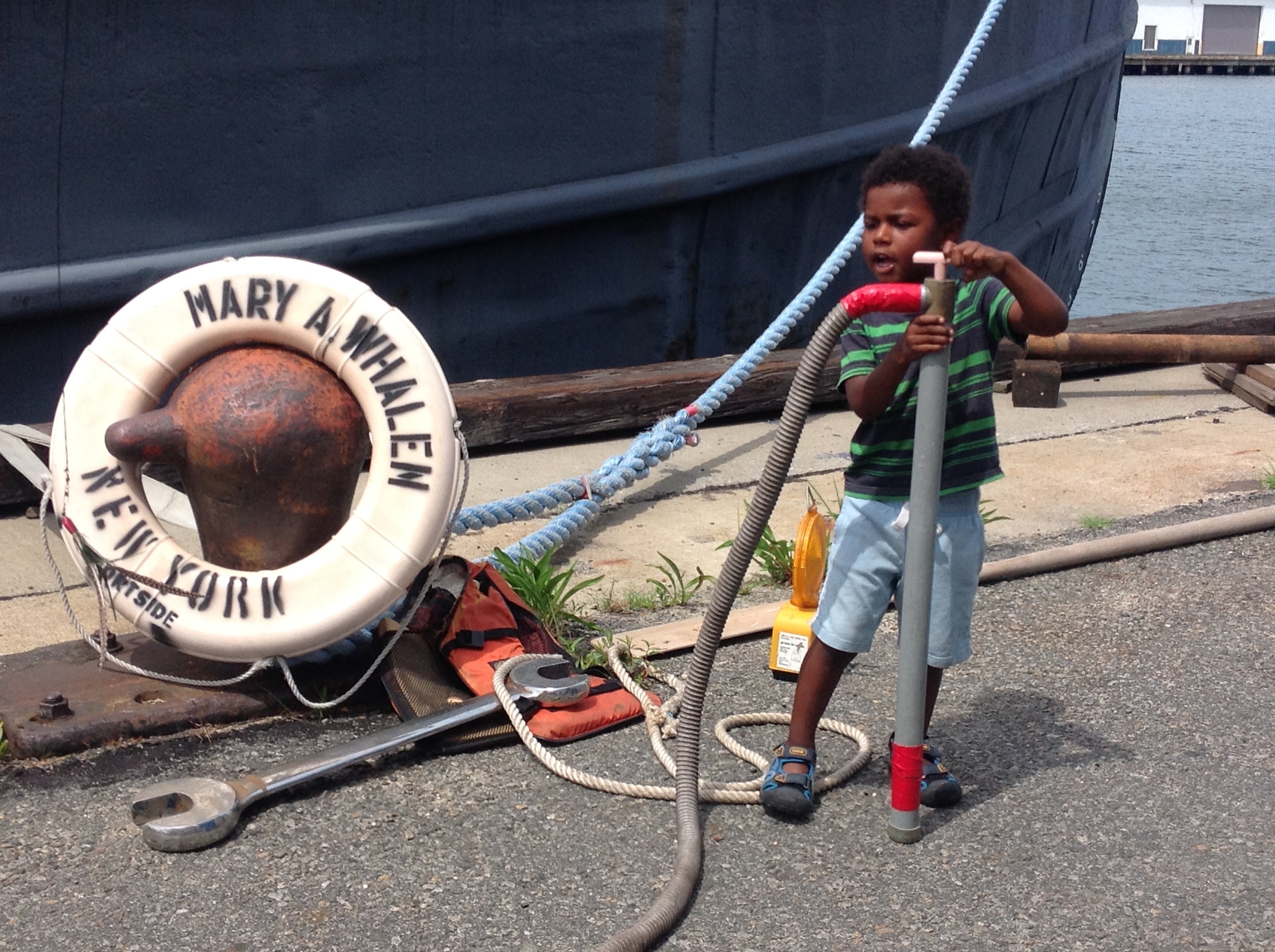
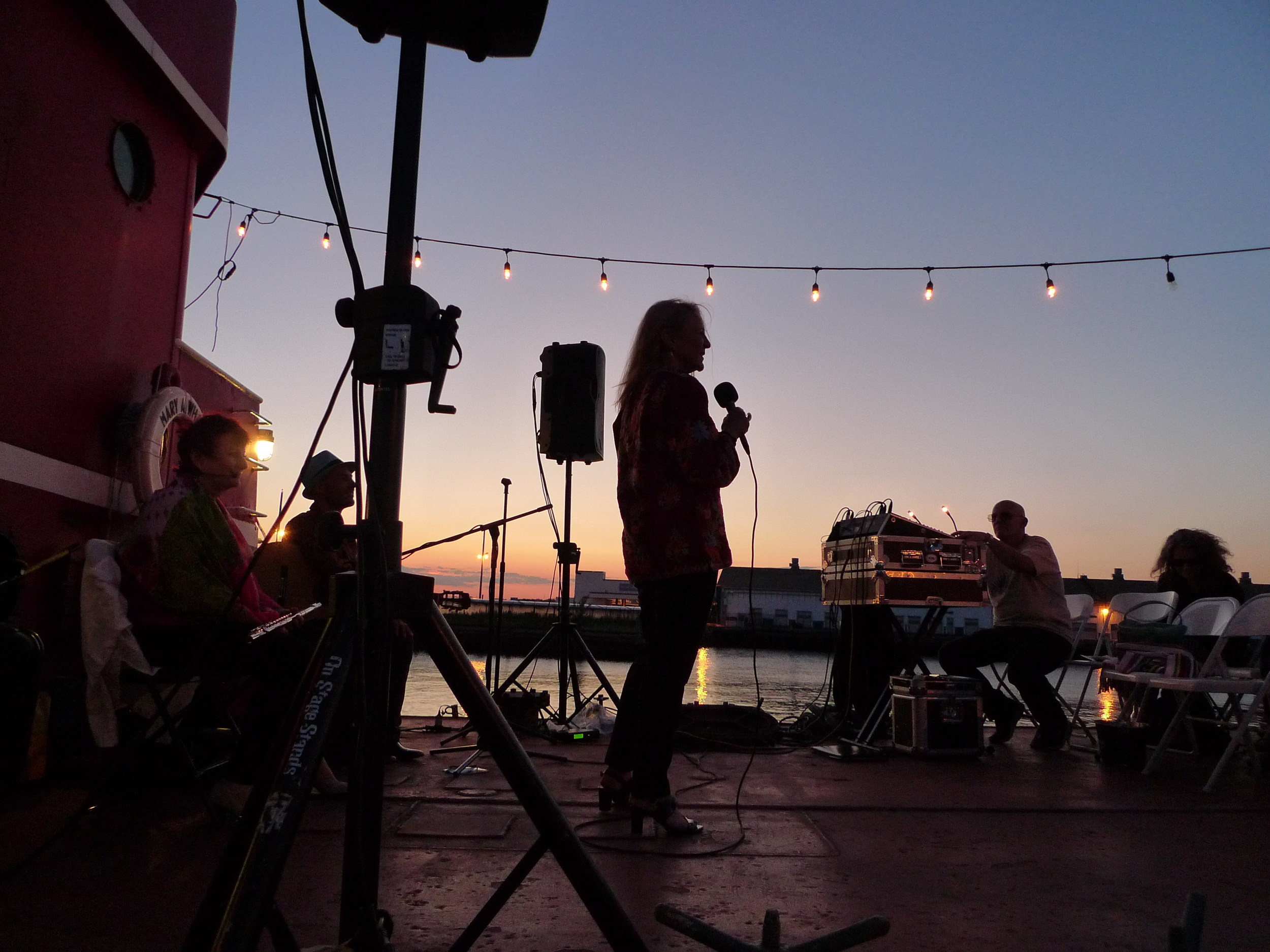
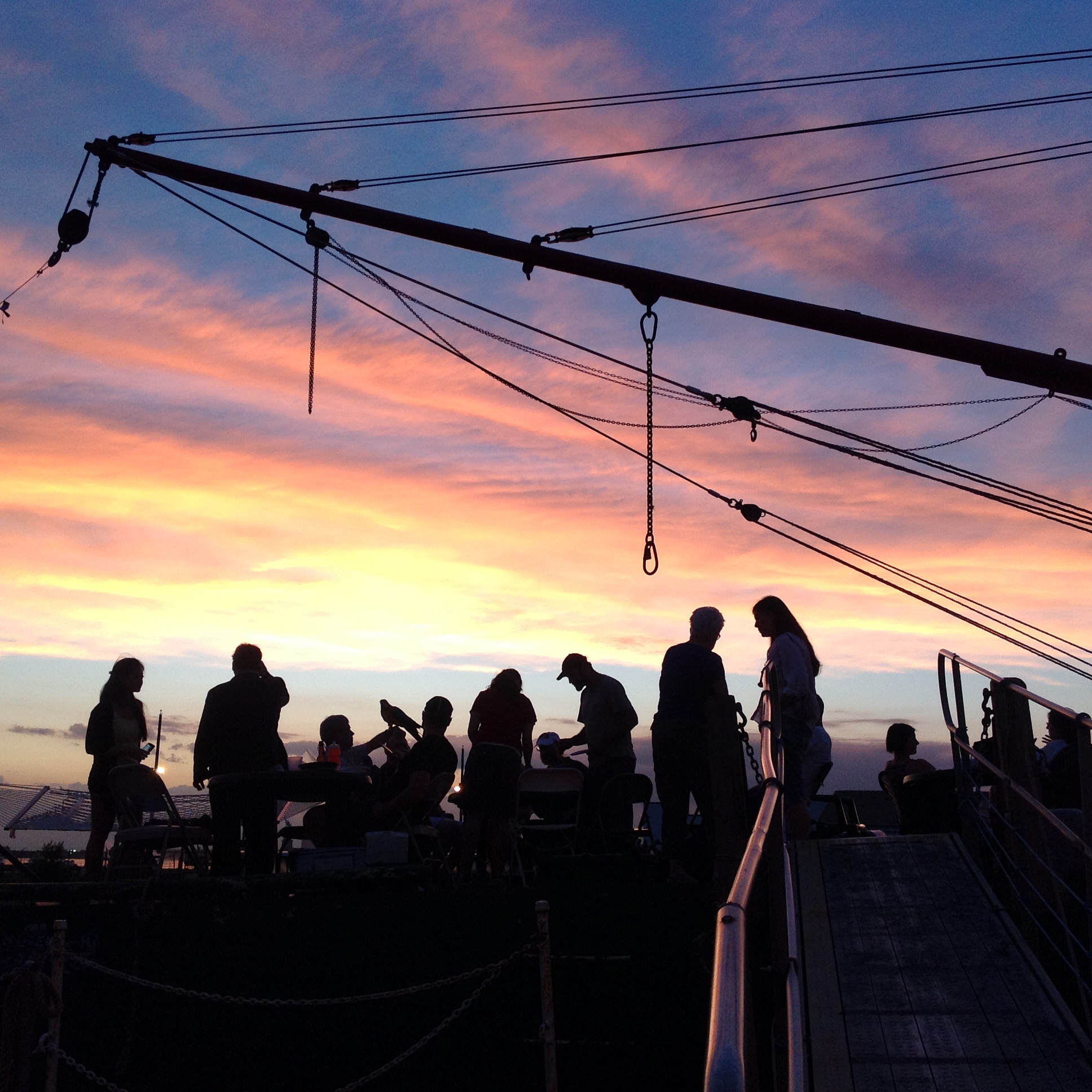
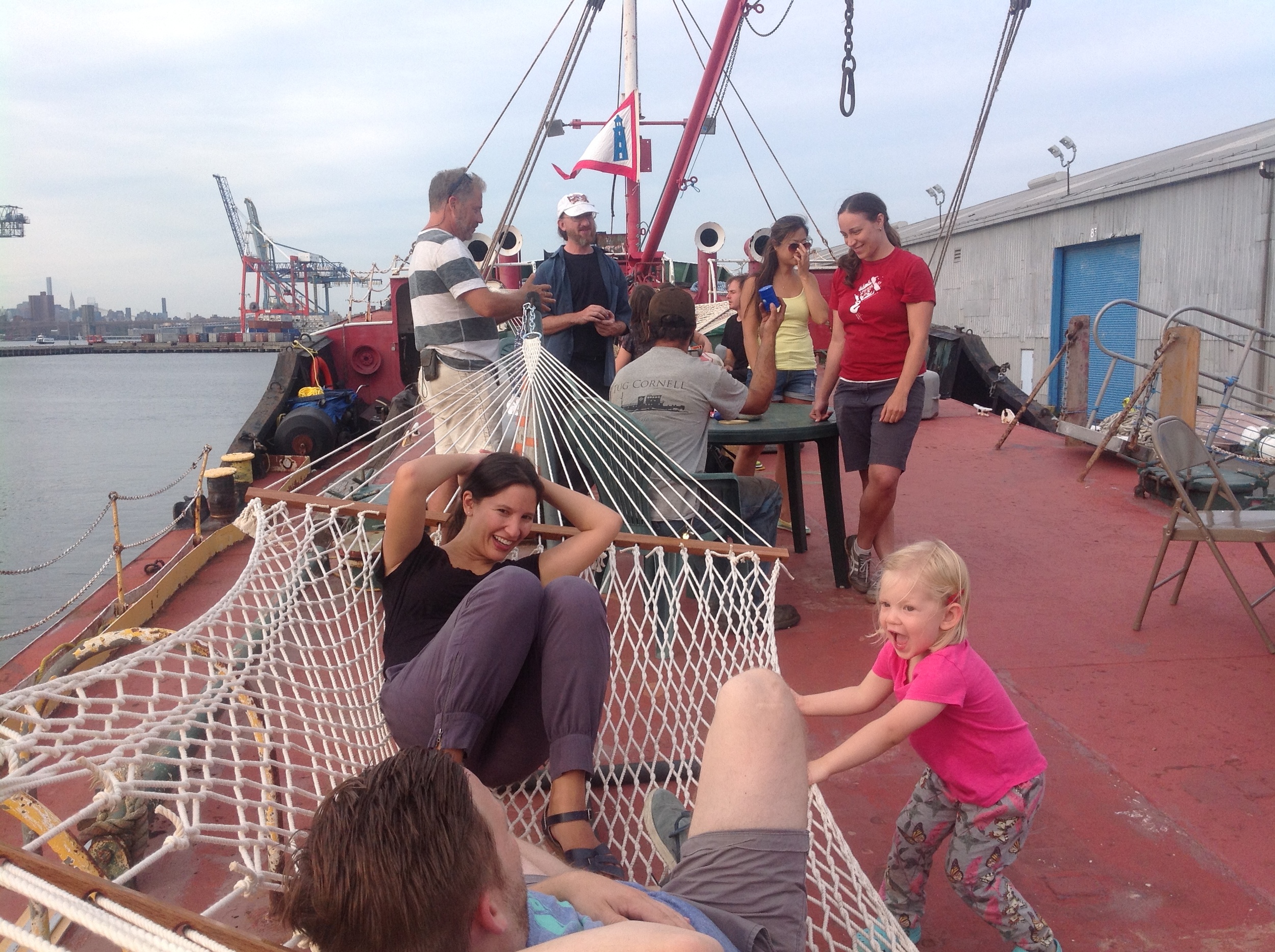
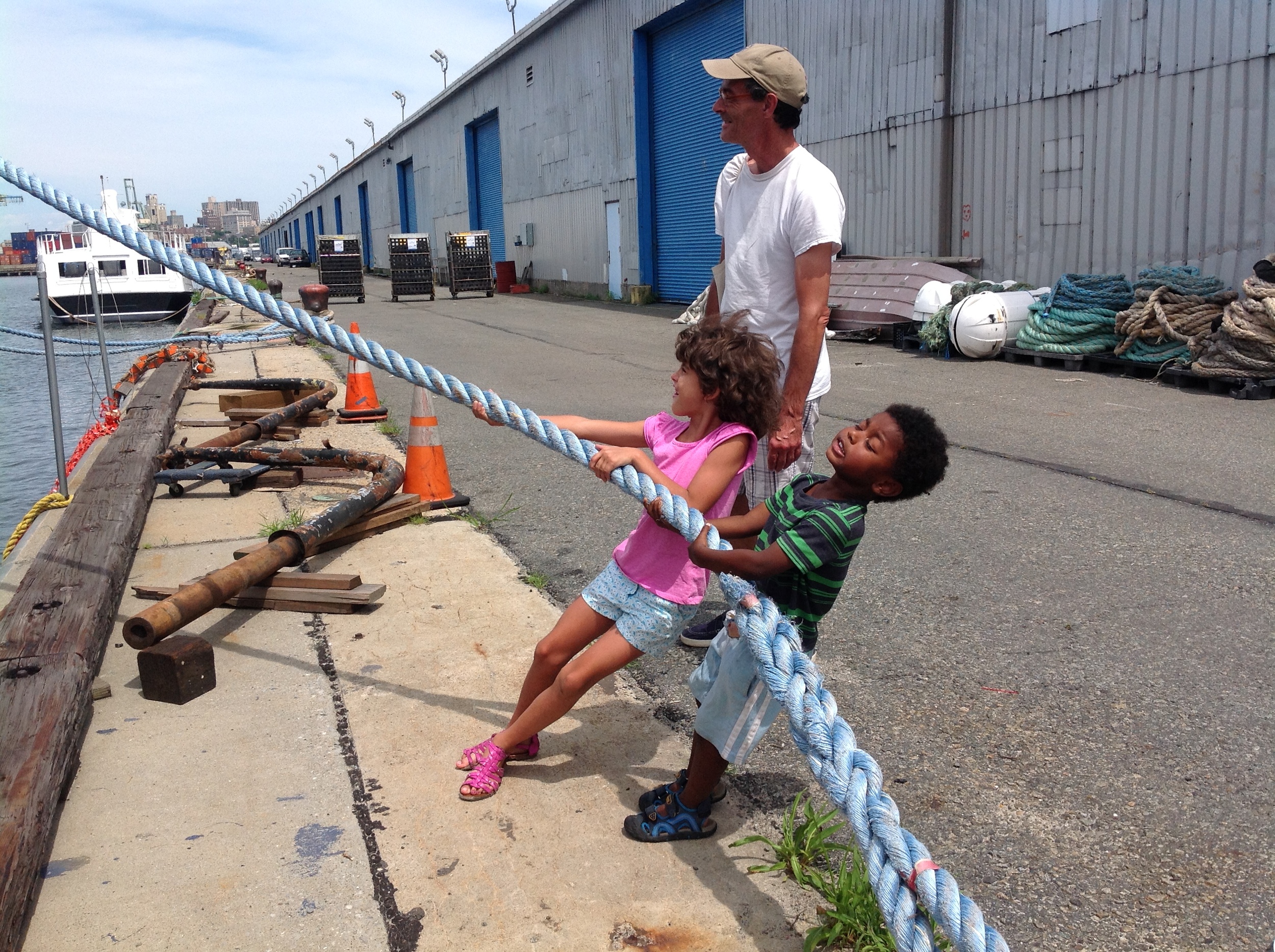
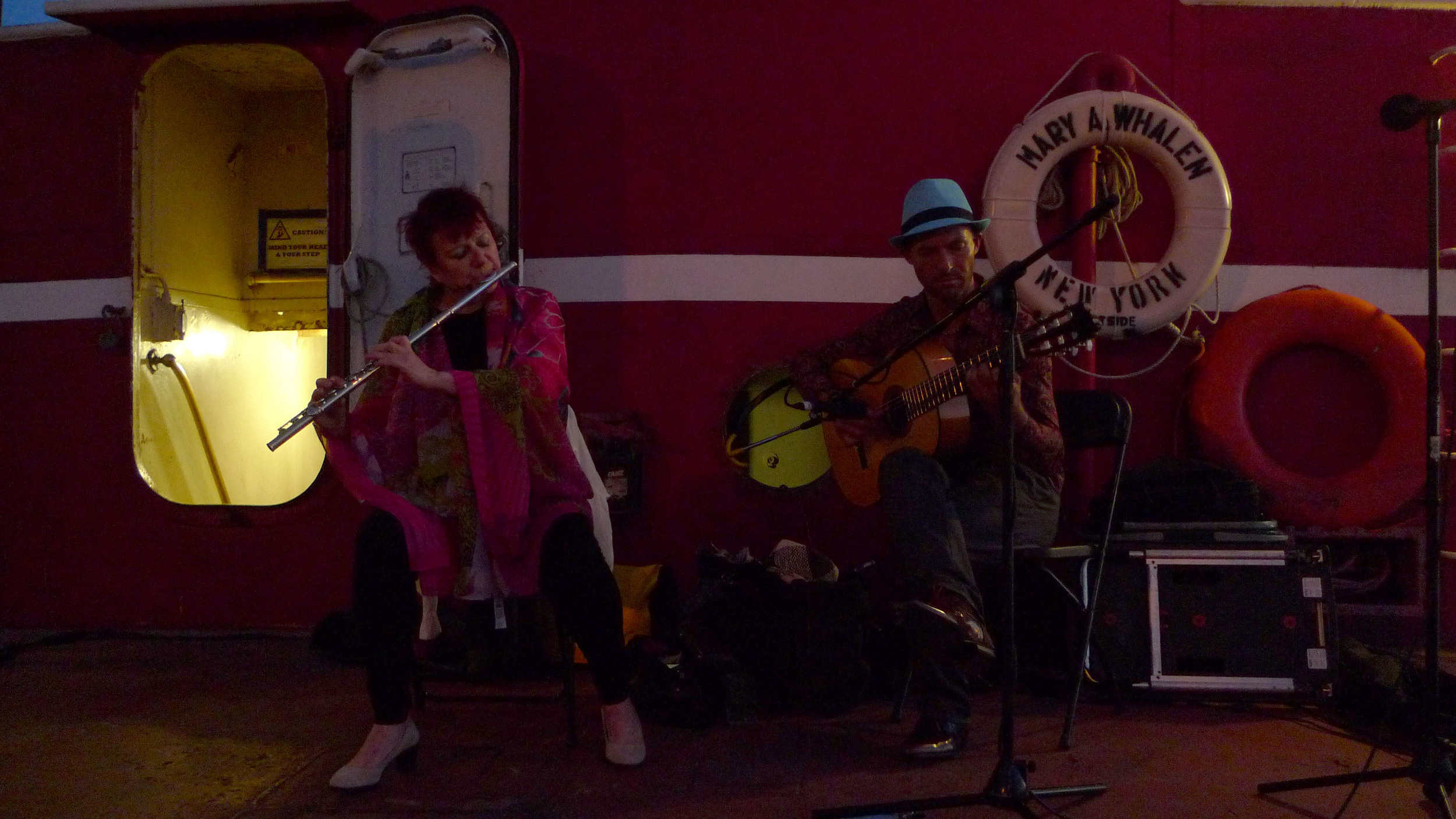
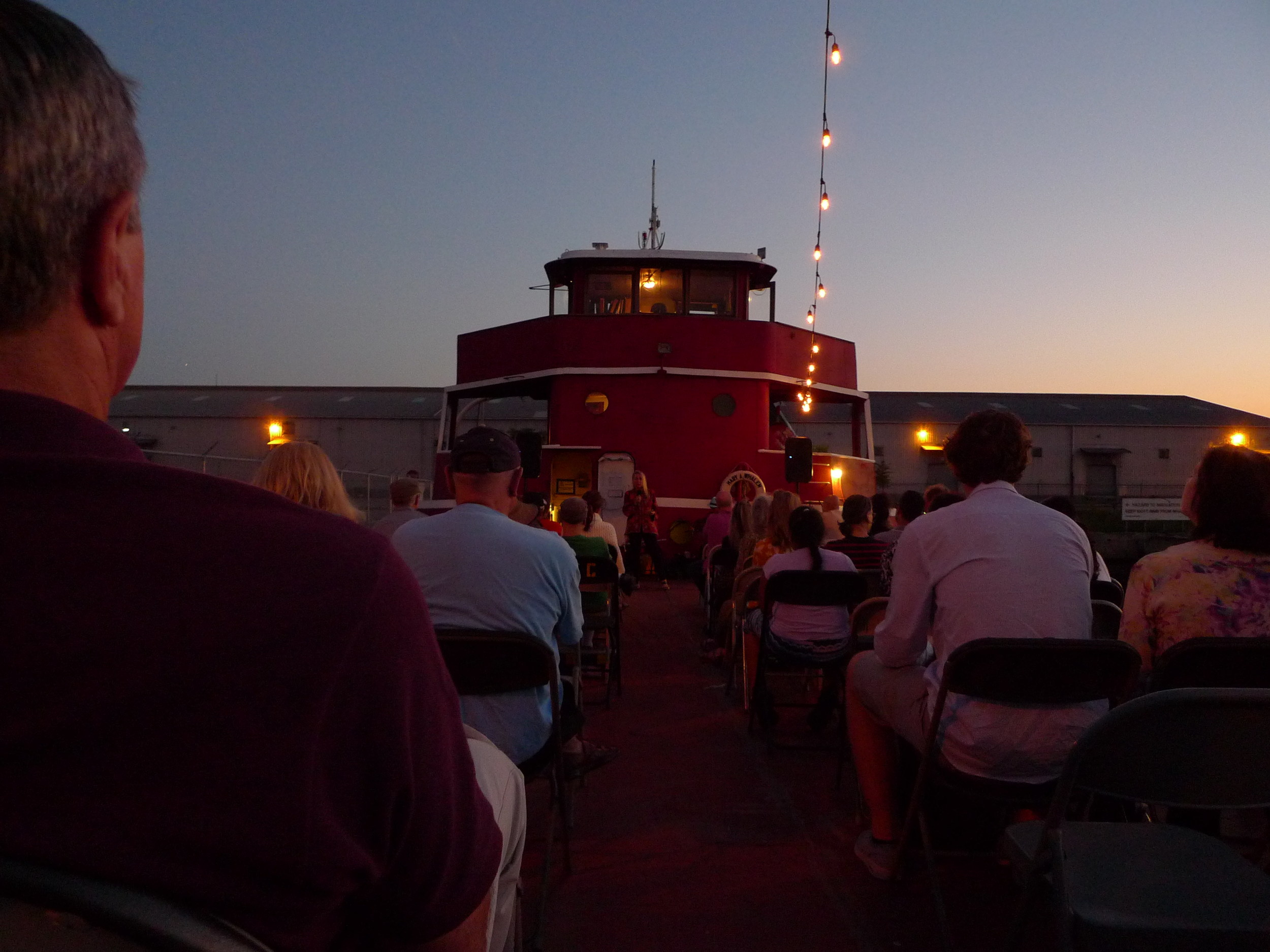
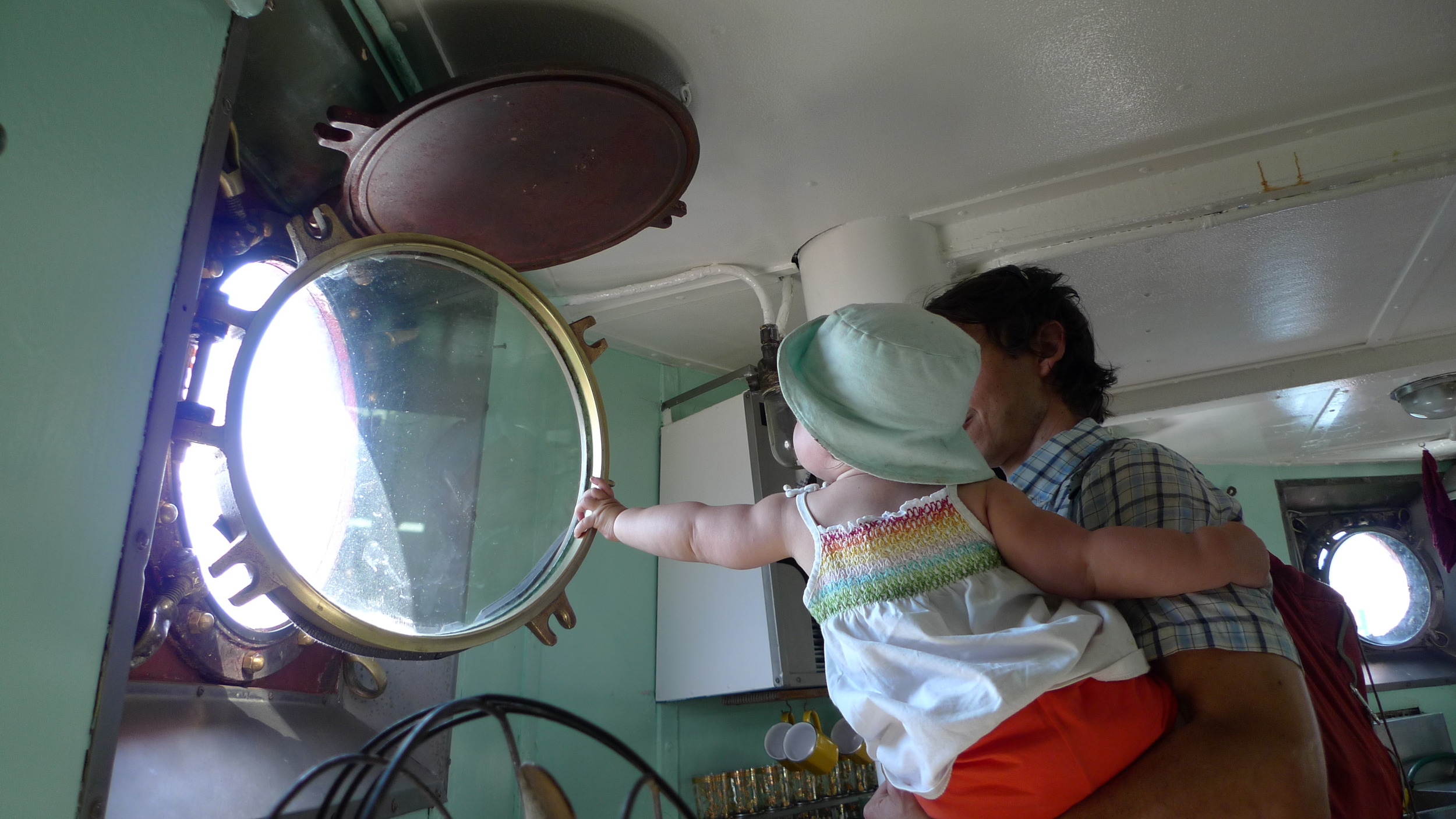
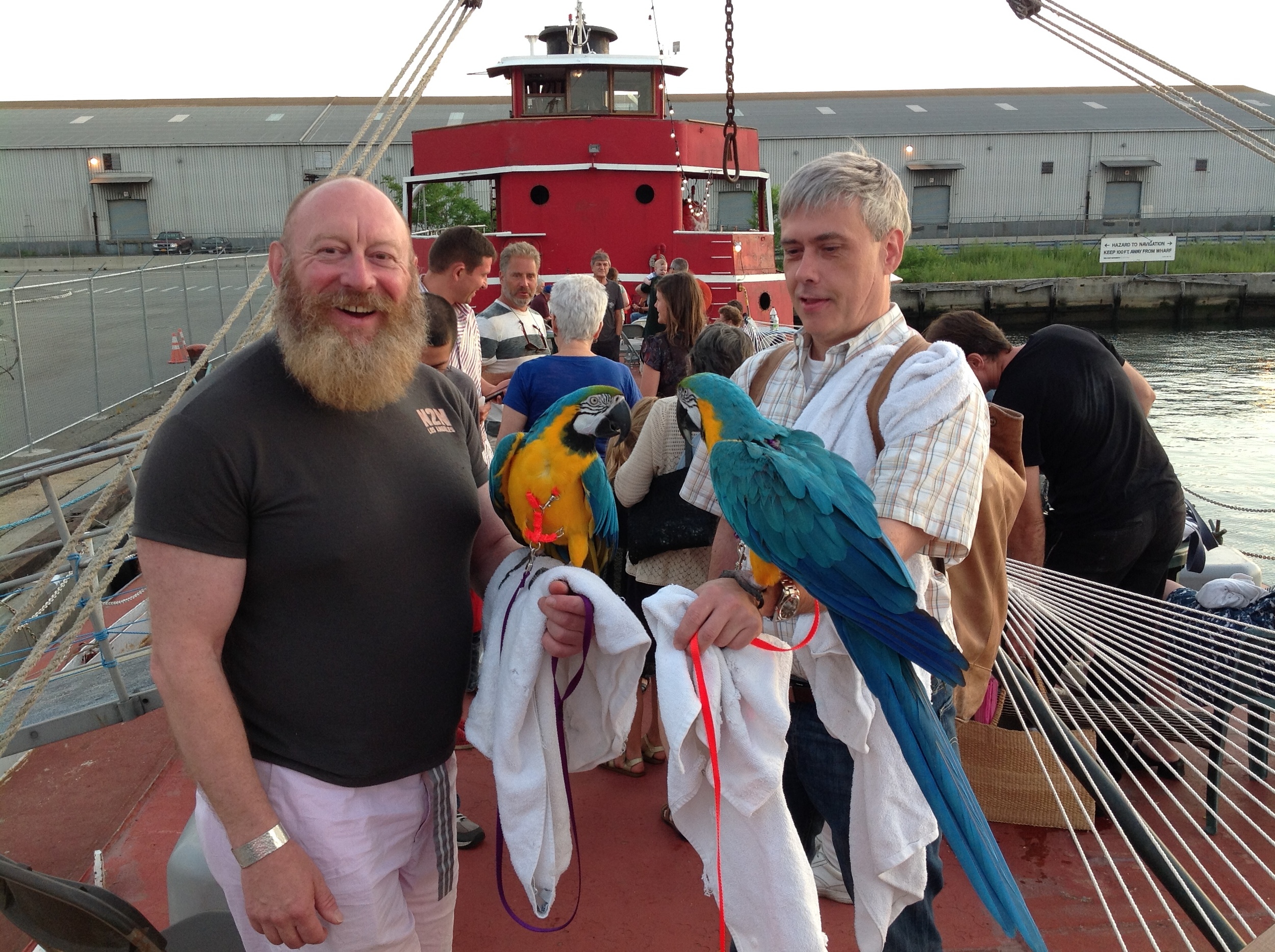

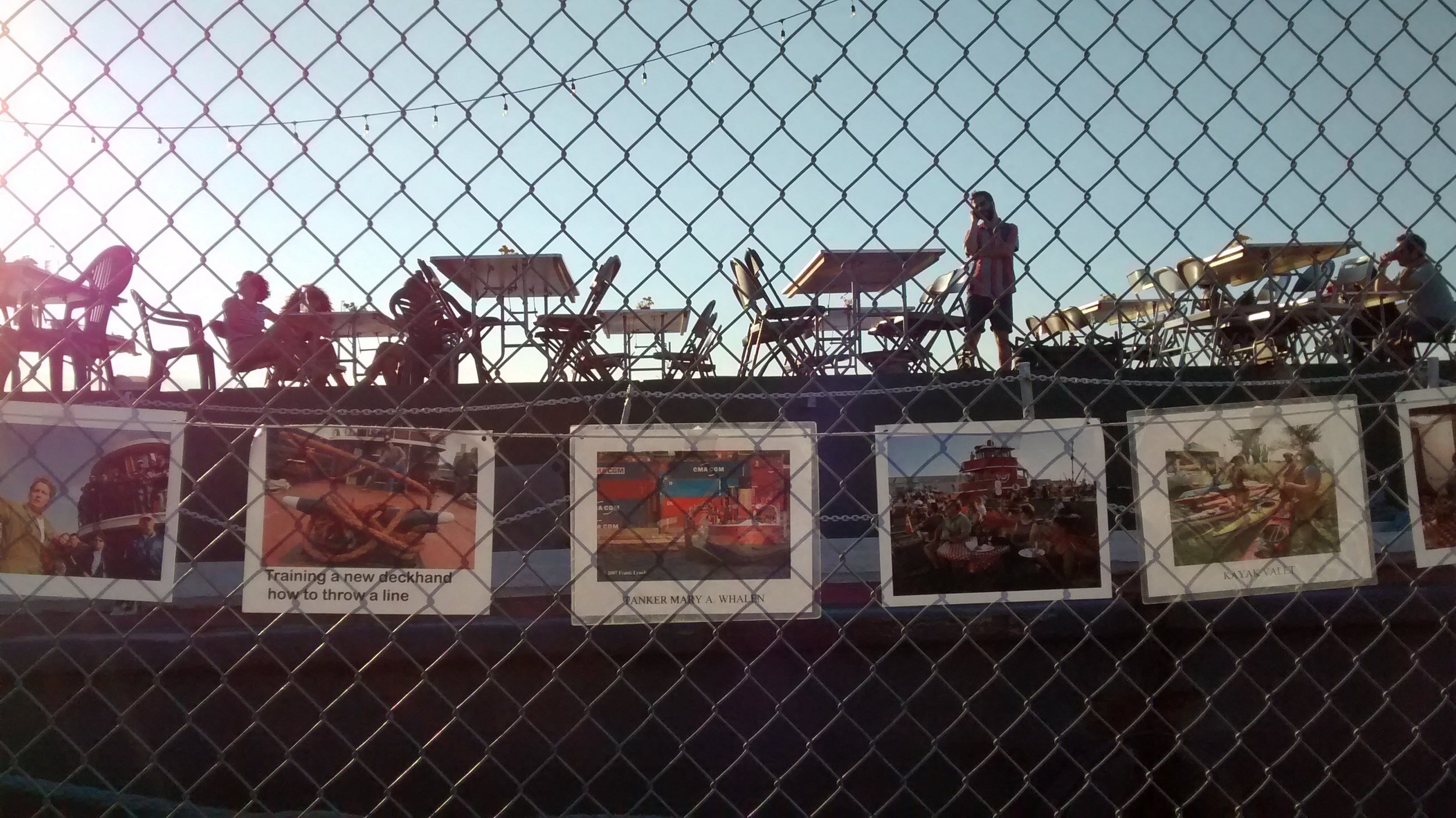
We secured $20,000 in funding from Councilman Carlos Menchaca to support our Red Hook WaterStories cultural tourism, placemaking and resiliency project. We were invited to join a historic ship flotilla that celebrated Cunard's 175th anniversary and got community members in the parade via our partner, the historic tug CORNELL. We curated and ran a great POW! weekend with TankerTours, TankerTime and gifted flamenco jazz musicians who have offered to make this an annual event. We produced a distinctive multimedia history night with Norwegian Red Hook WaterStories with bluegrass musicians from Norway, history speakers, and vintage video. Out shipcat Chiclet has become an attraction, with a growing fan club of regulars who come by to see her.
Volunteers repainted three cabins! Thank you, volunteers! Three summer interns from WHSAD did enormous work restoring the teak rail around the wheelhouse. The painters' union District Council 9 will repaint the exterior as a training excercise with paint donated by International Paint. DC9 scoped out the job, did some prep work, and laid plans for painting in 2016.
History runs through so many of our programs: all events on the ship, programs such as our Norwegian Red Hook WaterStories night, info content we share on our Facebook and Twitter, our blogposts such the one about the important sale of slave ERIE ship in Atlantic Basin which marked an important step in the end of slavery in the USA. In 2015, we added considerably to Mary A. Whalen history: more former crew members found us (thanks to our new home): Engineer Bill Siebert who works on a Vane tug and retired, 86-year old, former relief captain Thomas J. Smith. Captain Smith donated his maritime papers to us, and we have taped hours of interviews with him. A big boost in the history department was the visit by Scott Gellatly and his wife Pat. They ran a waterborne fuel transportation company years ago and almost bought the MARY. The Gellatlys donated photos, recorded hours of interview and brought along retired engineer Bryan Sinram, another trove of history, who had worked for Eklof, the company that ran the MARY WHALEN for years. Walter Barschow donated the folk painting of the MARY aground in the slide show above and gave us leads on Red Hook WaterStories about his family that ran a scrap yard for decades, founded by his German immigrant grandmother. Karen Dyrland and John Weaver donated another large cache of photos, letters and documents from Alf Dyrland, Captain of the MARY from 1962-1978. And, our home, the historic tanker MARY A. WHALEN turned 77!
PortSide continued to inspire filmmakers, painters and multi-media artists. Most find us because they can now see us. The MARY A. WHALEN is visible from our new friends and partners Pioneer Works which leads to a steady stream of artists coming to brainstorm, photograph, get ideas, one even collects salt water for a printing project. We gave the title to the documentary film BLUESPACE and appeared in it. We invited painter Jim Ebersole to memorialize our final week in the Red Hook Containerport.
This important work does not generate inspiring, cuddly or sexy photos. It involves a slew of emails and hundreds of conversations that advance our vision for bringing change to NYC's waterfront. Some highlights: Our President Carolina Salguero was appointed to the Sunset Park Task Force whose first task was to advise the EDC on creating an RFP for SBMT. How's that for alphabet soup! The Task Force continues to meet to shape the Sunset Park waterfront and industrial waterfront district. PortSide provided info and advice on the siting of a Citywide ferry stop in Red Hook. We are engaged with the ongoing work of Red Hook's NY Rising committee. We had a photogenic policy gig by being a stop on Alex Washburn's OHNY Resiliency bike tour.
Getting our new home in Atlantic Basin, has provided PortSide NewYork with much needed stability and allowed us to turn energies to growing PortSide's capacity. We grew the team with 2 board members and 4 advisory board members. We completed the long slog of paperwork of a FEMA Sandy Alternate Project application, along with other important funding applications. We were awarded $20,000 by Councilman Carlos Menchaca to support our Red Hook WaterStories project. In Late October, PortSide launched a year-long growth campaign #GetOnBoard. In December, we were awarded a competitive Regional Economic Development Council grant of $49,500 via the New York State Council on the Arts with the support of Governor Andrew M. Cuomo and the New York State Legislature. We scored new major sponsors in the Weather Channel and International Paint. There is strong growth in the number of entities reaching out to get involved: we have heard from college community service programs, schools, teachers and individuals.
Please donate now and support our momentum!
Sanding and painting needed in this executive suite asap. a false plywood floor has been cut and painted and needs to be installed after other surfaces are painted.
PortSide NewYork is preparing to have the historic ship MARY A. WHALEN be publicly accessible by summer. She and we will then be accessible for several years in a row, a real breakthrough after 10 years of operating as a pop-up in continual negotiations for short term permits. We hope you are as excited by this news as we are!
We could use some help getting ready, especially because the lingering winter weather delayed painting interior spaces on the ship before we moved our offices back aboard on April 30th.
Come enjoy spring weather on the waterfront and lend a hand. It's fun here! Join us!
To get involved, call 917-414-0565 or email portsidenewyork@gmail.com. More about volunteering in general here.
Finish painting the Captain's cabin. Sand and paint the Assistant Engineer's cabin below (currently the office of our President Carolina Salguero). Sand and paint the Tankermen's and Chief Engineer's cabin.
We need to move stuff around on the boat and move stuff off the boat. Things in the Tankermen's cabin go up to Captain's cabin once painting there is finished (it's almost done.) Contents of Chief Engineer's cabin are being taken off the boat to make space. Some stuff (some small, some heavy) goes into storage in the cargo tanks (that all involves fun with rigging). Btw, did you know that schlepp comes from the German word for tugboat?
Can you organize stuff? Like to clean?
Things have been piling up in main office space (two joined cabins) since the end-of-year Rigging Olympics and especially since we moved out of our shoreside office yesterday. We need to pack up and archjve some things until we can install better storage and desk system.
this is the fidley after yesterday's move of office from shore to ship. all t his has to get put away and the fidley deck needs a second coat of paint.
We seek a new office layout with custom desk surfaces and new storage units for our main shipboard office space below (two cabins joined by the previous owners). We have outgrown our current agglomeration of vintage steel desks and storage units. We have up to four people working in here at a time and much to store. Design needs to take into account that the ship moves.
We need to cut planks to put down a floor in another cargo tank to use it as a storage area. We need to install temporary plywood floors in two cabins used as office spaces.
Welding needed to finish sealing up the new hatch over cargo tank P2 which was cut late last year so we could store our large collection of vintage maritime artifacts down below. We have some other small welding repairs on hinges on steel doors etc. We are willing to pay for this work.
We could use some help with outreach to volunteers and event partners. This work requires a regular commitment of time over two months.
To get involved, call 917-414-0565 or email portsidenewyork(a)gmail.com. More about volunteering here.
Thanks!
Saturday 11/15/14 9am-5pm
Sunday 11/16/14 9am-5pm
Pier 9B, Red Hook Container Terminal, Brooklyn, 11231
Thursday and Friday, depending on crew availability
Lunch and pizza at end of day is on us. We can eat in the galley by the vintage stove or head to a local pizzeria; the work crew will vote to decide.
Enter port gate at Hamilton Avenue, Summit and Van Brunt Streets
Photo needed to enter. TWIC card holders especially appreciated!
RSVP by emailing portsidenewyork@gmail.com or calling 917-414-0565. If your tug is standing by and you're bored, you are welcome to tie up alongside and pitch in!
An INCREDIBLE amount of work has been done by POWERHOUSE volunteers, many of them who have taken time away from their own ship projects (be they not-for-profit or for profit vessels). There was great spirit and good humor while tons of steel were moved. Many thanks to you all!
Stevedore boss Sal came down the pier with other stevedores from the Pier 9B gang and hung another tire fender for us. Then, zip, zip, zip, with two forklifts they took all the stuff out of the shed that we thought we could move over the weekend. Thanks, guys!
Saturday 11/8/14, we had a very experienced work crew: Matt Perricone, Paul Strubeck, Amy Bucciferro, Christine Van Lenten, Mike Abegg, David Sharps, Peter Rothenberg and me, Carolina Salguero. Shipcat Chiclet loves projects like this and kept a close eye on all human endeavors. She is no dumb bunny, so she stays away from anything raised on boom or hoist and prefers to watch rigging from the pier. Activities in the shed, such as crate inspection and lumber moving, attracted her focused attention.
What we were moving and saving with this big project is artifacts from several significant Red Hook maritime businesses which closed in 2005, marking the end of an era: Todd Shipyard, Cowhey Brothers, and RMC Canvas and Rope, along with some odds and ends from here and there.
The artifacts include an array of marine hardware that will be used to explain rigging (over a span of decades) via a collection of diverse blocks, shackles, and turnbuckles. There are parts from WWII Liberty Ships, rope fenders; foundry molds, crates and crane plaques from the bridge cranes at Todd; a scale and line measuring device from Cowhey's, and more. Also, being moved are our event supplies (outdoor tables and chairs, signs, and sundry whatevers we use now and again such as Frank Hanavan's great costume version of the schooner PIONEER.)
Some large items of great importance to us include replacement parts of the engine on the MARY A. WHALEN, visible in the photo at right.
Paul Strubeck pulling out some pistons while Mike Abegg wears part of our Operation Christmas Cheer paraphinalia.
The marine business is so competitive that when the MARY A. WHALEN went out of service in 1994 due to a scored crankshaft, Eklof took the pistons, heads and rods out of the engine so that her buyers, Hughes Marine and Reinauer Transportation, dba Erie Basin Associates, could not repair the tanker and put her in competitive service. Just in case, Ekloff made them sign a covenant saying "we will not use the MARY A. WHALEN for fuel delivery service." She became their floating office, and a floating dock.
In 2008, PortSide NewYork bought spare engine parts from another Bushey tanker that had made its way to Seattle and was being scrapped there. Those parts were, unfortunately, in the shed when hurricane Sandy hit and now need some restoration work.
On Sunday, we were heartened when Nobby Peers, an engineer specializing in restoration work, told us the pistons looked really great! A few weeks after Sandy, we had pulled all the engine parts apart, and wiped everything down very liberally with WD40, four gallons of it!
The early birds, David Sharps, Christine Van Lenten and I moved things out of the forward engine room.
Paul Strubeck and Mike Abegg led the rigging and decided to not lift things aboard via whole pallet loads. Instead, they swung stuff over in smaller units, and got the big items out of the shed with a pallet jack. Peter Rothenberg preferred the hand truck. Amy Bucciferro assisted in moving things on the pier and on deck.
Matt Perricone's Saturday job was cutting the segment out of the deck (which will be converted into a hatch) so that we could load into one of the cargo tanks, which kept him busy a good part of the day. All tanks were vented and inspected before the job!
We threw a diverse set of tools at the job: chain falls, the ship boom, dollies, a hand truck, a pallet jack, an engine hoist, muscle and ingenuity and quite a few jokes.
By end of day, we had the overwhelming majority of things on deck, including the big items, the replacement heads and pistons for the engine in the MARY A. WHALEN.
Sunday, we had another extraordinary crew with Nobby Peers, Dan Goncharoff, David Sharps putting in a second day, Frank Hanavan, Jenny Kane who called her rigger friend Pete Betulia who joined us in the afternoon, Peter Rothenberg, and me, Carolina Salguero. Walter Dufresne and Mike Weiss were willing but the flu felled Walter and an truck break down kept Mike away.
Dan Goncharoff and Peter Rothenberg started out in the shed, trying to get the ends of the con rods and the bearings unbolted from the crankshaft in the lower engine block that was bought as a way to get another crank shaft (which sadly turned out to be damaged too). The nuts were seized, so Peter and Dan joined the work crew outside.
Frank Hanavan, David Sharps and Jenny Kane, and later joined by Peter Rothenberg, took on the task of laying down a plank floor inside the cargo tank. They developed their own intense cargo tank work crew. David and Peter where in the tank for a long while, and then David and Jenny became the chop saw team, with Frank the rigger running block and tackle and lowering things down most of the time.
The cargo tanks are really impressive spaces.
Nobby worked mostly alone for hours, with an occasional hand by me, until Jenny's friend Pete arrived. Nobby's mission was to get the heads and pistons into the engine room. He drilled a few holes in overhead flat bar beams in the entry companionway and in the fidley to hang two chainfalls and a come-along, and then hopscotched the heads in and down onto the engine one by one. The heads (from a 1951 engine) are slightly different from the original ones that would have been on the MARY, a 1938 engine.
Once Nobby was joined by Pete Betulia, the pace on the cylinder moving picked up; and sometime after dark, they started moving pistons in. Three of those made it to the engine room where Peter Rothenberg strapped them down on top of chocks he had cut at our on-deck chopsaw station. The last workers left around 10pm.
And then, just as I prayed would happen a few days ago, a tugboat friend arrived and tied up alongside, and I was able to get a hot shower. The plumbing on the MARY A. WHALEN is not yet restored.
In preparation to leave the containerport and to make way for a tenant in the shed, PortSide NewYork is clearing everything out of the Pier 9B shed. Everything must be out by 11/17!
Care to spend a nice fall day moving interesting antique marine hardware and vintage engine parts? Want to learn some rigging? Or practice the rigging you already know? Know how to drive a forklift? We could use you this weekend!
Saturday 11/8/14 9am-5pm
Sunday 11/9/14 9am-5pm
Pier 9B, Red Hook Container Terminal, Brooklyn, 11231
Pizza is on us afterwards. We can eat in the galley all cozy by the vintage stove or head to a local pizzeria; the work crew will vote to decide.
Enter port gate at Hamilton Avenue, Summit and Van Brunt Streets
Photo needed to enter. TWIC card holders especially appreciated!
RSVP by emailing portsidenewyork@gmail.com or calling 917-414-0565.
If your tug is standing by and you're bored, you are welcome to tie up alongside and pitch in!
Work plan
Saturday work will be led by Captain Matt Perricone who owns the historic tug CORNELL and other vessels and is a principal at Diamond Marine Services. He is also a licensed marine engineer.
Sunday work will be led by Nobby Peers, principal of Whitworth Marine Services, a world sailor and engineer who specializes in repairing and restoring vintage engines afloat and ashore.
Most stuff will come aboard the tanker MARY A. WHALEN. Things to move include replacement parts for the engine on the tanker MARY A. WHALEN, vintage maritime hardware and artifacts for exhibits we will save, and hardware and artifacts we will sell. There is one trip to the scrapyard to finally get rid of stuff hurricane Sandy flooded, so a volunteer with a pickup would be really appreciated!
We will use the boom from the MARY A. WHALEN to lift things onto the deck, at that point some of it heads to the engine room and most of it goes into a cargo tank.
Saturday: Matt Perricone will cut a hole in the deck plate so we can lower in full pallet loads of stuff. On a subsequent trip, he will make that plate a lift-able cover so that we can get in there again easily. On Saturday, we will focus on getting things into that newly opened cargo tank.
Sunday: Nobby Peers and crew will focus on getting things into the engine room. The engine heads will be installed on top of the cylinders in the engine room. The pistons have not yet had restoration work to revert the Sandy-damage done to them, so they will not go in the cylinders on the ship. They will be greased, wrapped and stored.
Davits will stay on the pier. Spare cylinders, lower engine block and fuel pump are headed to another shed.
We have news.
The MARY A. WHALEN is now the last of her kind in the USA. That’s because the tanker JOHN B. CADDELL, Staten Island’s symbol of Sandy’s wrath, has been scrapped. (See slide show right.)
Hurricane Sandy put the JOHN B. CADDELL on EDC property and cost the City a lot of money in fuel spill abatement, ship removal, ship storage and legal fees before the Sherriff’s auction.
At PortSide, we are very proud that we saved our MARY A. WHALEN from Sandy damage AND from damaging the property of others by breaking loose or riding up on to the pier.
Thanks to that, the MARY A. WHALEN is now a symbol of resilience, as is PortSide NewYork! Only the tough survive eight years of operating as a pop-up while looking for a home as we have.
We love our historic ship and want to make clear that we use her for a forward-looking purpose.
PortSide was founded to bring change to NYC’s waterfront and waterways, by advocacy and by the example of business and programs at a place called PortSide NewYork that we will create. The MARY A. WHALEN is our ambassador on that mission and will come and go from that place spreading the message, and our programs.
We recently retooled our official language to make the relationship of tanker and PortSide, our present and our future clearer. Here it is. Let us know what you think. We welcome your feedback!
PortSide is a living lab creating a vision for 21st century urban waterfronts – and waterways. Our focus is the water part, the BLUEspace, the Sixth Borough of NYC.
Our goal is to create a place that shows how to combine the working waterfront, public access and community development.
Our education, culture, workforce development and neighborhood promotion programs - all on a water theme –bring the community afloat and the community ashore together – for the benefit of all.
Building on our Sandy recovery work - which won us an award from the White House and honors from the NYS Senate - PortSide is developing flood preparedness and resiliency programs and will curate and house a resiliency center.
We export our programs via our ambassador, the historic ship, the MARY A. WHALEN, the only oil tanker in the world delivering public programs.
Support our fundraiser on Tuesday 10/28/14 “Resiliency is our HOOK.” Buy a ticket. Become a sponsor. Join the Host Committee and help sell tickets before the event. It will be a fun event with the rollicking Dixieland jazz of the Red Hook Ramblers and the great food and casual ambiance of Hometown Bar-B-Que restaurant. We greatly appreciate your support! As do the people and businesses who benefit from our resiliency work!
The transformation of the galley will knock your socks off! Decades of paint were removed from steel, bronze and Monel surfaces. The bulkhead was painted one of its early colors, a light, bright green typical in the 1930's when the ship was launched.
What made this project so challenging (beyond the scope of work) is that we are limited, since February 2012, to just 5 visitors at a time who do not have Homeland Security TWIC cards, and 5 such visitors can only be escorted in and out by our Director Carolina Salguero who has to stay aboard (eg, not leave for meetings) while they are aboard.
These rules have so impeded access to the ship that they have largely stopped volunteer shipwork (and programs) on the tanker. What inspired us to take on this big project is that Erika Stetson donated her entire month of December to us (as training for her entry to SUNY Maritime Academy) which broke the back on this work (and fortunately not on her!).
Paint removal and painting volunteers included Carol Salguero (Carolina's mother), Carla and Andrea Oviedo (visiting from Spain), Max Powell (driving 3 hours each way from Waterford for a few weekends), and our advisor Paul Amico. As this project went along, we also got assistance from The Red Hook Volunteers, FEMA Americorps members, and various individuals. Peter Guaracci, an actor and teacher, is our latest regular volunteer.
Putting the space back together was a project unto itself! Shipcat Chiclet was most engaged during the unpacking of the boxes. She did not like the noise of the paint chipping portion of this project. Needleguns are not for her!
We all delight in the gleam!
Dear Workboat crew,
Never paint the polished bronze! SO many layers of paint are on Mary Whalen's portholes and Monel porthole surrounds.
At first, we hoped to take the portholes entirely out, but getting them separated from the ship's steel proved too much. We are sending the swing plates, nuts, hinge pins and deadlights out for dip and strip polishing. The dogs will be another tedious matter.
Getting the hinge pins separated from the cast iron deadlights, which have corroded and swollen around the pins, has been a project requiring Zen patience, regular application of PB Blaster lubricant, heat, tapping, and prayer.
Tile restoration: Replace missing tile. Clean and restore existing tile. The white tiles are very discolored.
Repair of the wood paneled fridge and freezer: glue down some veneer bubbles, some re-varnishing. Change of freon, gaskets and compressors from DC to AC motors (or installation of a rectifier)
7 vintage cabinet latches. We can provide dimensions and details.
Furniture restoration and upholstery work: Restoration of the table stools. They should have backs. Some of the seats are not original. All should be reupholstered. New back and side cushion for the banquette, and re-upholstery of the banquette seat cushion to match.
Wood refinishing. Some sanding and varnishing of wood shelves and trim and parts of the fridge.
Two vintage fans. One was mounted on a wooden shelf, the other a "wall-mounted" model was on a bulkhead under the skylight. (We can provide dimensions).
Donations as ever!
Thanks!
Have you got experience repairing a 1941 Hyster Karry Krane? We could use your help! We expect to get a 1941 Fairbanks Morse engine from Kennett, Missouri in July, so we are interested in repairing our 1941 Hyster Karry Krane in order to have a crane to use to lift parts off that engine preparatory to bringing them aboard our ship MARY A. WHALEN. We will be using parts from the 1941 Kennett engine to restore the 1938 Fairbanks Morse engine in the MARY. Below is an edited version of our 2013 blogpost about our Hyster.
Our manual for the 1941 Hyster Karry Krane is here.
Another triumph! Another historic item for Red Hook! Our Hyster crane (built in 1941) has been deemed eligible to be on the National Register of Historic Places! and in record time~
In just two days, our Historian/Curator Peter Rothenberg researched the history of our 1941 Hyster and the history of this "Karry Krane" model, submitted an application to SHPO (the NYS Historical Preservation Office) to see if it was eligible to be listed on the National Register of Historic Places, and got that application approved!
We profusely thank the staff at SHPO for reviewing our application in just hours, and we also profusely thank Jenny Bernstein of FEMA who told us about the grant that prompted us to focus on the Hyster. The Hyster was flooded by Sandy, and the grant is for Sandy damage to historic and cultural resources.
PortSide applied for funding to reverse Sandy damage to the Hyster and to the replacement parts for MARY A. WHALEN's engine which were in the shed. The grant does not cover damage to historic documents which were flooded by Sandy.
We applied for for the Hyster, and for damages to MARY's engine parts we would use. (The grant would not cover damage to those engine parts we planned to sell to support the restoration of the MARY A. WHALEN's engine.) Earlier this year, we applied for FEMA Sandy recovery funds for Sandy damages, but we do not yet know if we will get funding. We did not apply until May 2013 because we were told in a November 2012 funding workshop that we were not eligible; that was corrected in May, at which point we immediately sought Sandy recover funds.
In short, getting on the National Register of Historic Places is a two-stage process: being "deemed eligible" and actually being listed. PortSide did the MARY A. WHALEN in two steps. For something to be on eligible or listed, it has to be deemed historical significant in some or all of the following ways:
Is it associated with an important person, event, or movement in history? Does it represent a significant design or technology, or is it a special example of a particular style? Is it the work of a recognized master? Could it yield important archaeological information about our past?
Here is our full application to SHPO in two parts.
Determination of Eligibility (DOE) for listing on the National Register
Supplemental History of Michael Cowhey
SHPO's response was "Thank you for pulling together this very compelling and fascinating history of the "Karry Krane" in such a short amount of time! Both myself and my colleague, Kath LaFrank of our NR Unit, have reviewed your submission and, based on the information provided, the Hyster "Karry Krane" is eligible for the State and National Registers of Historic Places. The only other somewhat similar type of property in NYS that we've called eligible is a historic steam shovel in LeRoy, NY. "
Todd Shipyard boomed during WWII. There were mobile cranes like ours in use at Todd. We have yet to check if the grain terminal used them.
The successor to our 1941 Hyster are the many forklifts used all over Red Hook.
The “Karry Krane” name was first used July 14, 1941. PortSide’s Crane is from 1941. PortSide’s crane is both one of the original Karry Kranes made and, while once common, is now one of the last of its kind.
This crane type was developed by Hyster during WWII and was very significant to the war effort here and overseas. It was used in shipbuilding facilities, in ports for cargo handling and for rebuilding after the war effort. It was such a useful vehicle that Hyster produced it overseas when it opened its first plant outside the USA in 1951. It became an international workhorse. We find documentation that shows it was used in New Zealand in addition to Europe.
This particular Hyster crane was last used by Cowhey Brother Marine Hardware in Red Hook which closed in 2005 and donated their final inventory to PortSide NewYork. The Cowhey family was in several forms of maritime business in Red Hook for about 140 years when three Cowheys wound down the business.
Cowhey’s bought the crane from the Staten Island Bethlehem Steel shipyard when that closed in the 1960s. We presume that the crane was new when purchased by Bethlehem Steel when that yard boomed during the war effort.
The crane dimensions are:
Body length 12’ 4”
Length of boom 10’ 1”
Overall length 22’ 3”
Height of body 3’ 3”
Height of boom 10’ 8”
1940: By experimental use of tractor frames, an advanced type of mobile crane is developed, later named the “Karry Krane."
1952: Hyster opens its first plant outside the USA, in Nijmegen, the Netherlands. The Hyster 40” and the Karry Krane are the first machines to be assembled there.
Criteria for evaluation.
This 1941 Hyster Karry Krane meets the following National Regsiter criteria:
(a) that are associated with history of a prominent Red Hook family and business. It is the last sizeable artifact of that business. It is related to a collection of other artifacts we have for that business. This particular crane is related to maritime history of NYC (two sites, one in Red Hook, one in Staten Island). And the crane model is particularly related to WWII history everywhere this crane became a major workhorse
(d) that have yielded, or may be likely to yield, information important in prehistory or history. It is a means to tell stories related to the Cowhey family and business in Red Hook, the Bethlehem Steel shipyard in Staten Island, WWII and reconstruction operations in civilian and military applications.
This is a 2.5 ton Hyster,the most popular World War 2,dock, lift and carry crane.they first came over on lease lend in 1941.
COLLECTION HYSTER KARRY KRANE MOBILE CRANE USAF USNAVY WWII
Establishing Willamette Ersted Co.
The company that would be known as Hyster Co. was founded by E.G. Swigert in 1929 under the name Willamette Ersted Co.[2] Initially, this company was established to manufacture logging winches for the forestry market in the Pacific Northwest, with headquarters in Portland, Oregon.
The Early Products
1934 saw the development of the straddle carrier with forks, which was one of the company’s earliest forklifts. Following this was the development of the BT, a forklift with a cable hoist system, able to lift 6,600 pounds (3,000 kg).[3] By 1940, the company began to manufacture its first piece of mobile lifting equipment, a mobile crane on a tractor frame, first known as a Cranemobile, later to be renamed Karry Krane. The Karry Kranes would prove to be very profitable for the company, as these lift trucks were used for loading and unloading massive cargo ships for importing and exporting purposes. In 1941, Willamette Ersted began recognizing a need for a smaller lift truck, and designed a new smaller model known as the Handy Andy. The following year, the Jumbo was introduced as the company’s first product to use pneumatic tires and a telescoping mast.
Operations in Peoria
In the company’s early years, one of its prominent customers was Caterpillar Tractor Co. Caterpillar held an exclusive contract with the company, whereby Willamette Ersted Co. would manufacture specialized winches for Caterpillar’s logging tractors. In light of this, the company decided in 1936 to open a warehouse and distribution center in Peoria, Illinois, where Caterpillar was headquartered. By 1940, Willamette Ersted Co. had begun full-scale manufacturing of products at its Peoria location.
For more info check out... http://www.ritchiewiki.com/wiki/index.php/Hyster_Co.
The story of this business is a means to cover several topics: how an immigrant family rises in stature, the growth of a marine business from “speculator” (eg, the maritime version of the scrap collectors with shopping carts today, someone who collected scrap metal by going boat to boat in the harbor), to a purveyor of nautical antiquities to the wealthy, then a marine hardware supplier and the operator of a port in Albany.
The Cowhey family grew in prominence in Red Hook from their speculator days in the 1860s, and at the peak of the business, they owned most of a block in the vicinity of their final outpost at 440 Van Brunt Street.
In 2005, as the business wound down, the Cowhey family operated a terminal in Albany of Federal Marine Terminals http://www.fmtcargo.com/.
Chronology of Cowhey family in Red Hook (for more, see attached history about Michael Cowhey)
John Cowhey started his business about 1862 [1937 obit says business started about 75 years ago]
By the time his son Michael Cowhey was running it, the business, John Cowhey Sons at 400 Van Brunt was a ship wrecking and salvage firm. The company was well known to decorators looking for nautical articles.
John Cowhey was famous for purchasing in 1911 the RELIANCE a racing yacht which one the America’s cup, dismantling her and selling her fittings and scrapping her parts. The 110-foot mast went to the Federal Baseball League park.
Michael Cowhey. d. 1937 had a wife Regina [or Margret according to a different source], a daughter Regina and two sons Thomas and John.
Thomas M. Cowhey in 1990 was the title holder to 440 Van Brunt which was built c. 1931, altered in 1957.
A Brooklyn Daily Eagle, Jan. 20, 1931 article describes John Cowhey as "one of the influential citizens of Red Hook" in his day.
The same article tells that Michael had in his yard several large old church bells that he had bought for scrap but had decided to hold on to. The bells rang eerily in the night but:
"If some one suggested that the ghost of an old Bailing ship skipper might be behind the tolling, he would nod solemnly. Then he would ask if his questioner had ever heard how in 1880 the wind blew so hard that Red Hook was white with scales, blown clean off the harbor fish, and how all the houses on the Hook had to be held in place by anchors. And how once it was so cold that he, Michael Cowhey, was able to walk barefooted over the ice to Staten Island. "